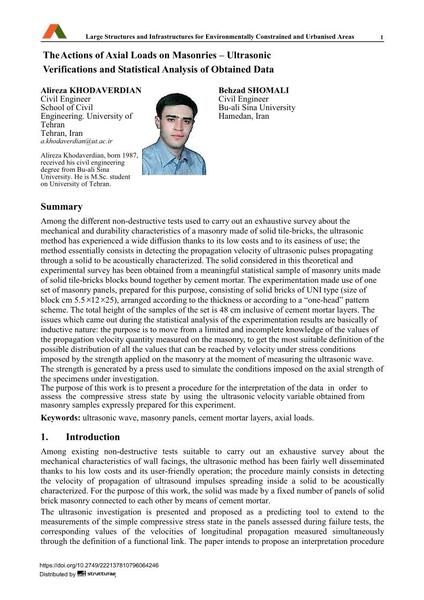The Actions of Axial Loads on Masonries – Ultrasonic Verifications and Statistical Analysis of Obtained Data

|
|
|||||||||||
Bibliographic Details
| Author(s): |
Alireza Khodaverdian
Behzad Shomali |
||||
|---|---|---|---|---|---|
| Medium: | conference paper | ||||
| Language(s): | English | ||||
| Conference: | IABSE Symposium: Large Structures and Infrastructures for Environmentally Constrained and Urbanised Areas, Venice, Italy, 22-24 September 2010 | ||||
| Published in: | IABSE Symposium Venice 2010 | ||||
|
|||||
| Page(s): | 886-887 | ||||
| Total no. of pages: | 6 | ||||
| Year: | 2010 | ||||
| DOI: | 10.2749/222137810796064246 | ||||
| Abstract: |
Among the different non-destructive tests used to carry out an exhaustive survey about the mechanical and durability characteristics of a masonry made of solid tile-bricks, the ultrasonic method has experienced a wide diffusion thanks to its low costs and to its easiness of use; the method essentially consists in detecting the propagation velocity of ultrasonic pulses propagating through a solid to be acoustically characterized. The solid considered in this theoretical and experimental survey has been obtained from a meaningful statistical sample of masonry units made of solid tile-bricks blocks bound together by cement mortar. The experimentation made use of one set of masonry panels, prepared for this purpose, consisting of solid bricks of UNI type (size of block cm 5.5 12 25), arranged according to the thickness or according to a “one-head” pattern scheme. The total height of the samples of the set is 48 cm inclusive of cement mortar layers. The issues which came out during the statistical analysis of the experimentation results are basically of inductive nature: the purpose is to move from a limited and incomplete knowledge of the values of the propagation velocity quantity measured on the masonry, to get the most suitable definition of the possible distribution of all the values that can be reached by velocity under stress conditions imposed by the strength applied on the masonry at the moment of measuring the ultrasonic wave. The strength is generated by a press used to simulate the conditions imposed on the axial strength of the specimens under investigation. The purpose of this work is to present a procedure for the interpretation of the data in order to assess the compressive stress state by using the ultrasonic velocity variable obtained from masonry samples expressly prepared for this experiment. |
||||
| Keywords: |
ultrasonic wave masonry panels cement mortar layers axial loads
|
||||
